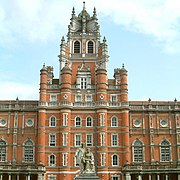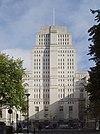Bedford College, London
Bedford College, University of London, was founded in London in 1849 as a higher education college for the education of women. It was the first institution of its type for women in the United Kingdom. In 1900, the college became a constituent school of the University of London. It played a leading role in the advancement of women in higher education, and also in public life in general. The college became fully coeducational in the 1960s. In 1985, Bedford College merged with another of the University of London's colleges – Royal Holloway College. The merged institution was named Royal Holloway and Bedford New College (RHBNC). While this is still the official name, for day-to-day use the college is called Royal Holloway, University of London (RHUL).
History of Bedford College

The college was founded by Elizabeth Jesser Reid (née Sturch), a social reformer and anti-slavery activist, who had been left a private income by her late husband, Dr. John Reid, which she used to patronise various philanthropic causes. Mrs. Reid and her circle of well-educated friends were firm believers in the need for improving education for women. In 1849, she leased a house at 47 Bedford Square in the Bloomsbury area of London, and opened the Ladies College in Bedford Square. The intention was to provide a liberal and non-sectarian education for women, something no other institution in the United Kingdom provided at the time. Reid placed £1,500 (GBP) with three male trustees, and persuaded a number of her friends to serve on the management committees and act as teaching professors.
At the outset, the governance of the College was in the hands of the Ladies Committee (comprising some influential women), and the General Committee made up of the Ladies, the professors of the college and three trustees. The General Committee (later the Council) soon took over the running of the College, while the Ladies Committee directed the work of the Lady Visitors, who were responsible for the welfare and discipline of the students, and also acted as their chaperones. Initially the professors were shocked by the generally low educational standards of the women entering the college, who for the most part came in having had home-based, governess education. In response to this, Reid founded a school close to the college in 1853, in an attempt to provide a better standard of entry. In 1860, the college expanded into 48 Bedford Square, which enabled it to become a residential establishment. "The Residence" was under the charge of a matron, who introduced the practice of students helping towards the running of the house, and keeping their own accounts.
Elizabeth Reid died in 1866, and left the college in the hands of three female trustees. These three women defied the views of the Council that the existing funds should be invested in the running of the school (which was closed in 1868), and instead ensured that the trust fund was used to improve conditions and teaching at the college, and establish it as a fully fledged institute of higher education. The trustees insisted upon a new constitution (as the college had no legal charter at the time). The Council was replaced by a Committee of Management, and the college was reconstituted as an Association under the Board of Trade, and officially became known as Bedford College.
In 1874, the Bedford Square lease expired and the college moved to 8 and 9 York Place, off Baker Street. The two houses acted as one, with the college using the downstairs rooms, and the upstairs being the Residence. As numbers began to rise, the college expanded with the addition of extensions housing science laboratories. In the late-1870s, an entrance examination was introduced, and a preparatory department set up for those who did not meet the standards required for college-level entry.
In 1878, degree examinations of the University of London were opened to women. Bedford College students began gaining University of London Bachelor of Arts, Bachelor of Science and Masters degrees from the early-1880s.
In 1900, when the University of London became a teaching university (where it had previously been only a degree-awarding body), Bedford College became one of the university's constituent colleges. The college applied to the Privy Council for a Royal Charter to take the place of its Deed of Incorporation. Royal Assent for the new chartered body was received in 1909, and the College became officially recognised as Bedford College for Women.
Continued growth of the college led to a search for new premises, which culminated in the purchase of the lease of a site at Regent's Park in 1908. A major fund-raising effort was undertaken to provide the new site with modern amenities. The new purpose-built buildings were designed by the architect Basil Champneys, and were officially opened by Queen Mary in 1913.[1] The buildings continued to be extended and rebuilt throughout the 70 years that the college spent at Regent's Park, especially following extensive damage caused by wartime bombing.
Bedford firsts include:
· first woman professor at an English university (Caroline Spurgeon)
· first Social Sciences department in the UK, established 1918
· first woman Vice-Chancellor
· first women factory inspectors under the 1913 Health Act
· first woman to be appointed to the Companionship of the Order of the Bath
· one of the first two women Fellows of the Royal Society
· fourth woman chairman of the TUC - Trades Union Congress, Marie Patterson
· the first art school in England where women could draw from life
· first bob cut: Bedford launched the fashion for bobbed hair (when the first bobbed head was seen it is recorded that it "nearly caused other students to faint.")
After a brief period of admitting a small number of male postgraduate students, the college became fully coeducational when 47 men passed through clearing in 1965, and the name reverted to Bedford College.
In the early 1980s, Bedford College had approximately 1,700 students and 200 academic staff based in 20 departments.
Merger with Royal Holloway
In 1985, Bedford College merged with Royal Holloway College, another college of the University of London which, like Bedford College, had been a college for women only when it was first founded. The merged institution took Royal Holloway College's premises in Egham, Surrey, just outside London, as its main campus and took on the name of Royal Holloway and Bedford New College (RHBNC). The decision to drop the Bedford name from day-to-day use caused some discontent among graduates of Bedford College, who felt that their old college had now essentially been taken over by Royal Holloway, and that Bedford College's name and history as a pioneering institution in the field of women's education were being forgotten. In an attempt to give more prominence to the Bedford name, the merged college named a large, newly-built library in the centre of its campus the "Bedford Library". However relations between RHUL and some of the Bedford College alumni today remain somewhat strained. Nevertheless, many Bedford College alumni maintain links with RHUL, supporting alumni events and other college work.
Bedford College's old premises at Regent's Park is now the home of Regent's College.
Notable alumni
- Catherine Ashton, High Representative of the Union for Foreign Affairs and Security Policy (European Union)
- Elizabeth Blackwell
- Caroline Barron, Historian specialising in medieval London
- Dinah Craik
- George Eliot
- Penelope Farmer
- Dame Janet Finch, Vice-Chancellor and Professor of Social Relations at Keele University 1995-2010
- Nick Kent [1]
- Angela Mason
- John Moloney comedian and writer
- Jeremy Northam (1961-), English actor[2]
- Rosalind Pitt-Rivers FRS (1907-1990), biochemist
- Hazel Alden Reason
- Jean Rook, journalist
- Miranda Seymour
- Audrey Smith, cryobiologist
- Mary Treadgold, author
- Valerie Vaz, current MP for South Walsall
- Amanda Vickery
- Evelyn Whitaker (1844–1929), children's writer
- Alice Zimmern, translator and suffragist
Principals
See also
- Elizabeth Jesser Reid
- Alumni of Bedford College (London)
- Royal Holloway, University of London
- Lillian Penson
References
- ^ "The University of London - The Constituent Colleges", British History Online.
- ^ Royal Holloway, University of London. The Independent, 2007-07-27. Retrieved on 2008-08-29.
External links
- History of Royal Holloway and Bedford New College
- Royal Holloway, University of London Archives
- Genesis website page on Bedford College's archived papers
- Genesis website page on Elizabeth Jesser Reid's archived papers
- Notable Alumnae webpage of Royal Holloway and Bedford New College
- Bedford College student lists
- Bedford College in World Ward II, accessed 27 May 2012


